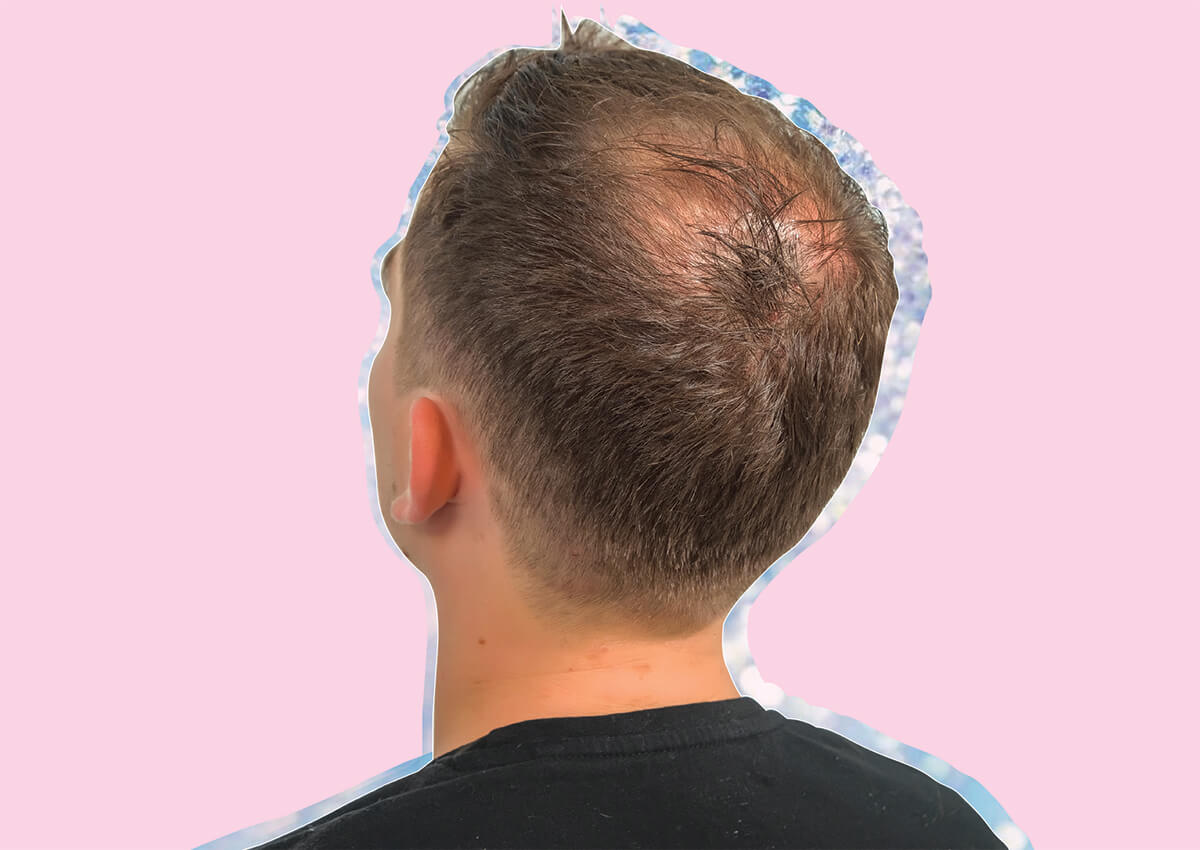Male Pattern Baldness: Causes, Prevention & The Best Treatments

Have you ever noticed that balding in men usually happens in a patterned way? While women often experience all-over thinning that’s more obvious at the hairline and part, men begin balding at the crown, above the temples, and at the front. Today, following on from requests from our amazing beauty community, we’re doing a deep dive on male pattern baldness, including what it is and what causes it. We’re also discussing effective measures you can take to slow down (and sometimes even halt) male pattern baldness along with treatment options for those who have more severe cases.
What is Male Pattern Baldness?
While men can experience different types of hair loss, the most common form is “male pattern baldness,” which is medically referred to as androgenetic alopecia. In the United States alone, this form of hair loss affects 50 million men. In fact, 50% of males over age 50 are likely to experience a mild to severe case, and by age 70 up to 80% of men are affected.
“Our hair has growth cycles, but when a patient develops androgenic alopecia, the growth cycle becomes weaker and the follicles shrink. Eventually, the hair withers until new hair stops growing,” explains Dr. Annie Gonzalez, a board-certified dermatologist at Riverchase Dermatology in Miami, Florida. “Hair loss caused by male pattern baldness can begin at the crown of a man’s head or on the side at the temples. Some patients develop a bald spot, while others experience a continuously receding hairline. Many times, if not treated, the hairline will recede until most of the hair is gone.”
Male Pattern Baldness Stages
In order to determine the severity of male pattern baldness – AKA how much it’s progressed – doctors refer to the Hamilton-Norwood Scale. This scale outlines seven different “stages” of male pattern baldness ranging from class 1 (none to minimal hair loss) to class 7 (almost entirely bald).
You can refer to this diagram below to see how each stage progresses:

What are the Causes of Male Pattern Baldness?
We can point to several key causes of male pattern baldness: genetics, hormones, and age. Usually, all three are pretty intertwined.
Genetics
One of the biggest clues as to who may experience male pattern baldness is whether it runs in the family. “Genetics is a big clue for who is more prone to male pattern baldness,” says Dr. Gonzalez. “If a man has close relatives who have lost their hair naturally, then it is a likelier predicament for them.”
She adds that relatives on the maternal side are seen as having more connection to male pattern baldness in younger generations. In other words, if your mom’s dad and grandpa are balding, there may be a higher chance you will experience the same.
Age
You are probably well aware that there’s a correlation between age and balding. That doesn’t mean balding can’t occur in someone’s teens or 20s, but it is certainly rarer. Dr. Gonzalez says, “On average, we see patients in their 30s, 40s, and 50s starting to lose their hair. However, there are [outlier] cases where teens experience male pattern baldness, as well as men in their 20s.”
Note that genetics factors in here. If someone is in their 30s through 50s and they do not have a family history of balding, they may not experience male pattern baldness. Conversely, if your balding runs in your family – especially on your maternal side – then the combination of age and genetics may lead to the onset of male pattern baldness.
Hormones
“Male pattern baldness is caused by hormones such as testosterone and dihydrotestosterone and their effect on the scalp hair follicles,” says Dr. Eric Rudnick, a board-certified dermatologist at Dazzling Dermatology in Boca Raton, Florida. “In patients with this hormonal type of hair loss, genetics give a predisposition for development of the characteristic male-pattern baldness. As these hormones interact with the hair follicle, the hair itself begins to miniaturize which, over time, gives the appearance of thinning or balding in the affected area.”
Can Anything Else Cause Male Pattern Baldness?
The three factors listed above are the biggies, but some other conditions can cause baldness as a side effect. For instance, issues with the thyroid, fungal infections, cancer, and certain medications can result in hair loss. This hair loss may preset in the type male pattern or otherwise, but in either case it becomes important to treat the underlying issue first – not the side effect.
Posts You'll Love:
What is the Best Way to Treat Male Pattern Baldness?
Treating male pattern baldness right away is super important. The quicker you jump into action, the less hair you’ll ultimately lose and the more likely you’ll be able to reverse some of the previous hair loss.
“It is easier to slow down the balding process than it is to stimulate the regrowth of hair,” explains Dr. Gonzalez. “Also, once that hair follicle withers and that hair growth cycle stops, the only [treatment] option is surgery.”
Dr. Rudnick agrees, stressing the importance of visiting with a board-certified dermatologist as soon as you notice any hair loss, or if you anticipate (based on genetics) hair loss in your future. Your dermatologist will diagnose your male pattern baldness based on the Hamilton-Norwood scale we mentioned above, providing you with a tailored plan that maximizes your treatment efficacy. They’ll also be able to set realistic expectations for you based on your progression of male pattern baldness.
“A combination of prescription medications and/or over-the-counter supplements, and possible injections may be used in order to see improvement,” says Dr. Rudnick. He adds, “Men with late-stage male pattern baldness may have a difficult time achieving meaningful results and, in these cases, hair regrowth may not be possible.”
The most common treatments for the early stages of male pattern baldness are the over-the-counter options that use Minoxidil as their active ingredient. The most well-known brand name is Rogaine, which can halt the thinning of the hair but will have to be used regularly and continuously (like, forever) in order to avoid the continuation of balding.
“There are also laser options in the form of caps, helmets, and brushes that release laser rays that may help treat hair loss,” says Dr. Gonzalez. “However, note that clinical research into these devices is less substantive than the results we’ve seen from Minoxidil.”
In terms of prescription options, your doctor will determine the severity of the hair loss – as well as any positive results you’ve achieved with over-the-counter treatments – and go from there. Finasteride, a medication that’s used to treat enlarged prostates, can also be used to help slow the progression of baldness.
“Finasteride can take months to produce visible results and will have to be taken regularly to avoid the reignition of the recession,” says Dr. Gonzalez. “Also, because it is an oral medication, your doctor will have to go through any significant side effects with you, and if after a year of using the medication, no significant result can be accomplished, you will most likely be advised to stop taking it.”
What Treatment Options Are Best for More Advanced Baldness?
Once you start venturing into late-stage male pattern baldness, many hair follicles have died and unfortunately there’s no bringing them back to life. In these cases, it’s less about reversing the hair loss and more about utilizing technologies and procedures that aesthetically fix the issue if that’s a path you’d want to explore.
Platelet Rich Plasma (PRP)
This treatment for male pattern baldness is more of an intermediary (or even supplemental) option in more advanced, but not extreme, cases of hair loss. In the treatment, the doctor will take a small amount of your blood and then extract the platelet-rich plasma from it. This is a rich substance that’s full of proteins and growth factors.
From there, the PRP will be re-injected into the area to help trigger new growth. It’s not going to be effective on follicles that are completely dead, but anecdotally it yields positive results in about 60% of patients who are candidates. Like other treatments, it does need to be repeated two to three times a year and it is unfortunately not cheap.
Tattooing
Medically referred to as “scalp micro pigmentation (SMP),” this treatment approach essentially tattoos very tiny dots in areas where hair is thin. It’s not really a fix for extreme balding and it will need touch ups over time, but it can create the illusion of more hair since the scalp isn’t as visible. Think of it as brow microblading for your head.
Hair Transplants
The most common option for late-stage male pattern baldness is a hair transplant – AKA hair grafting or hair implants. This process essentially takes grafts from healthy hair follicles and places them in the affected bald areas. (FYI, a hair transplant is essentially a modern version of old-school hair plugs.)
While this doesn’t reverse or stop the progression of the balding itself – and not all transferred hair will survive – it can yield a natural-looking result when done well. It’s very important to work with someone who’s highly skilled in this area, though, because subpar results can look kind of wonky.
Wigs
You can also experiment with wigs at any point. There are even long-wear options that provide the look of a natural head of hair. Again, it’s a matter of finding a hairstylist who’s killing the game here – like this talented pro. A bonus is that there’s zero surgery required and it’s way less expensive compared to some of the other options here (though it ultimately may require more upkeep)
Of course, you can always just own your baldness! Just make sure to wear sunscreen with a minumum SPF 50 every day. 😉






















Leave a comment